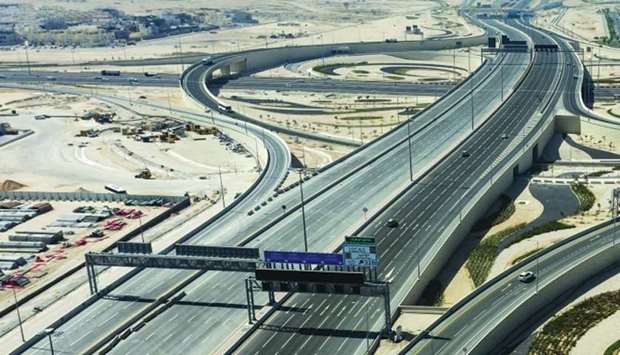* Opening to take place on Saturday, July 11
* 92% of works on Mesaimeer Interchange completed
* New route will provide direct traffic flow from Mesaieed, Al Wakra, Al Wukair towards Doha, 22 February Street and Al Shamal Road
The Public Works Authority (Ashghal) has announced that it will open a 7km road, linking Doha Expressway and Southern Doha Expressway at Mesaimeer Interchange, on July 11 to ensure free and direct traffic flow from Mesaieed, Al Wakra and Al Wukair towards Doha, 22 February Street and Al Shamal Road.
This will be done in co-ordination with the General Directorate of Traffic.
In a statement on Wednesday, Ashghal said it had opened the lanes to Al Wakra in March and would open the other lanes from Al Wakra to improve traffic in both directions. The route has 4-6 lanes in each direction to allow some 20,000 vehicles per hour in both directions, saving around 70% of travel time.
More importantly, the road will enable a direct link with the Al Janoub, Ras Abu Aboud Stadium and Al Thumama stadiums as it integrates with other major arteries, running from Umm Besher Interchange on G-Ring Road and Southern Doha Expressway, through Al Wetiyyat Interchange on Sabah Al Ahmad Corridor, onto Mesaimeer Interchange along with Doha Expressway, E-Ring Road, Industrial Area Road and Rawdat Al Khail Street.
Ashghal will open the right access at Umm Besher Interchange on G-Ring Road from Al Wakra and Al Wukair via Southern Doha Expressway, as well as two more accesses at Al Wetiyyat Interchange on Sabah Al Ahmad Corridor from Al Thumama, Air Force Interchange and from Bu Hamour and Mesaimeer towards Mesaimeer Interchange, the statement explained.

The new openings will offer new alternative routes and shortcuts, alleviating traffic pressure at Airport Interchange and Air Force Interchange on Airport Street along with Al Thumama Interchange on Najma Street, and shifting traffic to Al Wetiyyat Interchange, Mesaimeer Interchange and the roads connected to Doha Expressway, Rawdat Al Khail Road, Industrial Area Road and E-Ring Road.
Hassan al-Ghanim from the Highway Projects Department said the new road is a direct link between the south and north of the country. Road users coming from Mesaieed in the north and vice-versa can use a direct and free route without any traffic signals to shorten the journey time by about 70%.
Al-Ghanim explained that most parts of Mesaimeer Interchange have been opened to traffic so far. About 92% of the works on the vital interchange
has been finished, he said, adding that a tunnel is to be completed and opened soon so that the whole interchange is open for traffic.
* Traffic Flow
Those arriving from the southern part of Doha Expressway will be able to continue on Umm Besher Interchange on G-Ring Road and then use Al Wetiyyat Interchange on Sabah Al Ahmad Corridor, passing through Mesaimeer Interchange and reaching Doha Expressway and 22 February Street. Those arriving from Ras Bu Abboud Street, Al Wakra Road and G-Ring Road will be able to turn right at Umm Besher Interchange and then use the Al Wetiyyat Interchange on Sabah Al Ahmad Corridor via Mesaimeer Interchange, reaching Doha Expressway and 22 February Street.

Commuters travelling from Hamad International Airport and Al Thumama via Sabah Al Ahmad Corridor will also be able to turn right at the Al Wetiyyat intersection, passing through Mesaimeer Interchange and reaching Doha Expressway and 22 February Street.
Road users arriving from Mesaimeer can use the exit loop at Mesaimeer Interchange to reach Nuaija and 22 February Street.
* Underpass Benefits
The three-level Mesaimeer Interchange is the first of its kind in Qatar as it contains nine underpasses providing free-flow traffic, Ashghal has stressed. The interchange contains two main bridges connecting Rawdat Al Khail Street and Industrial Area Road in both directions, in addition to
connecting E-Ring Road with the southern part of Doha Expressway in one direction, which will achieve "great flow of traffic in all directions".
The project involves 6.1km length of construction works, with 3-4 lanes in each direction to accommodate about 30,000 vehicles per hour in both directions. The new interchange will significantly improve traffic, reducing travel time by more than 70%, the statement notes.
* Hexagon Interchange
Mesaimeer Interchange is the first of its kind in Qatar connecting six main roads, namely Mesaimeer Interchange, Doha Expressway, southern part of Doha Expressway, Sabah Al Ahmed Corridor, Industrial Area Road and Rawdat Al Khail Street. The interchange also provides a vital traffic link between the south, central and north of the country. It links traffic from the south through the southern part of Doha Expressway, main carriageway of Doha Expressway and Al Shamal Road.
It also connects traffic between Industrial Area Road and the heart of Doha through a connection to Rawdat Al Khail Street, which intersects with D-Ring and C-Ring roads, and also between the busy areas of Nuaija, Al Thumama, Bu Hamour, Al Maamoura and Mesaimeer, providing easy
access to Al Wakra, Al Wukair and the Industrial Area.
It is located in a vital area that has many facilities, including Al Thumama Stadium, one of the World Cup venues. The interchange has three pedestrian bridges that will help ease people’s access to the stadium.
The interchange also serves many important educational, health and commercial facilities such as the Medical Commission, Meteorological
Department, many schools, health centres and nearby shopping malls.
* Integration with Sabah Al Ahmad Corridor
The newly constructed Mesaimeer Interchange integrates with Sabah Al Ahmad Corridor through its connection to Al Wetiyyat Interchange, which is a strategic link between the southern part of Doha Expressway with Doha’s main highway, to provide free-flowing traffic between the north of Doha and its south.
The project is a vital one with two levels comprising three bridges and four vehicle underpasses to provide easy access to the nearby residential areas such as Al Thumama, Mesaimeer, Bu Hamour, Nuaija and Al Wakra, as well as free-flowing traffic for road users towards Hamad International Airport, the southern areas, Doha, and then to the northern areas of the country.



